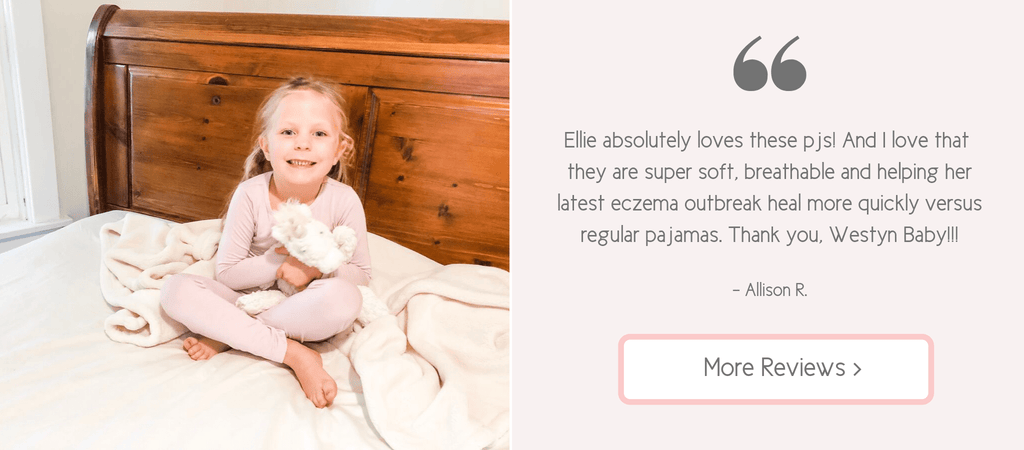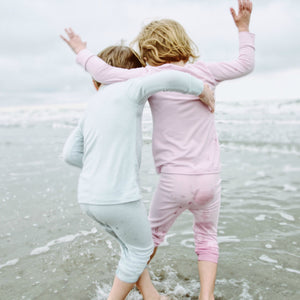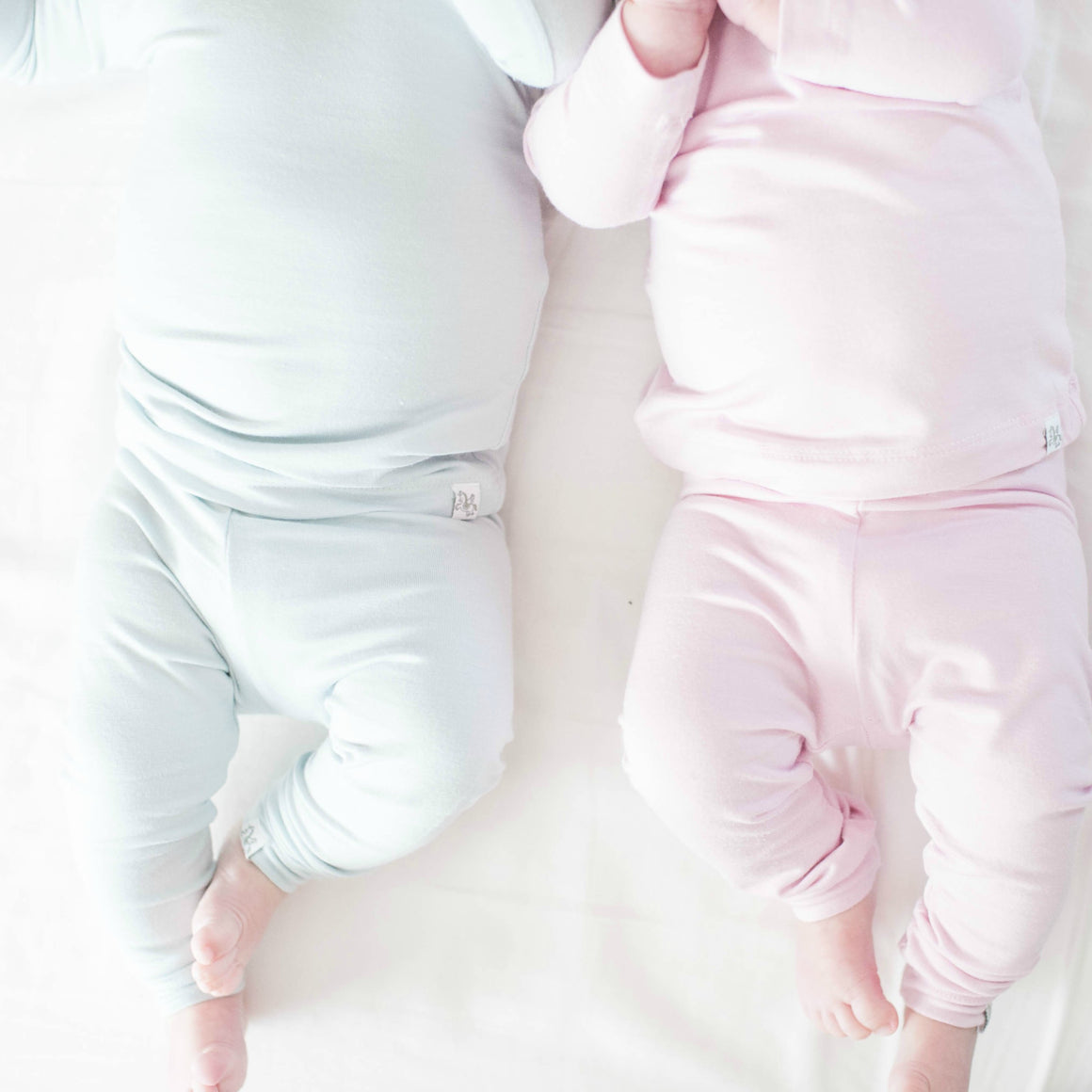What Is the Best Fabric for Eczema?
If you have a child with eczema, you’ve likely noticed a correlation between the clothing you choose and the impact on your little one’s skin’s condition. When looking for eczema friendly clothing, perhaps the most important consideration is fabric. Sweat is one of the most common triggers of itch in people with eczema. To avoid this trigger, eczema-prone skin should be dressed in lightweight, breathable clothing. Wearing cool, air-permeable fabrics can help to prevent skin irritation and reduce eczema flares. So what is the best fabric for eczema - cotton, silk, wool? We’ll touch on that along with fabrics you should avoid altogether since they are known to be irritating to sensitive skin. We’ll also mention a few common clothing chemicals you’ll want to steer clear of since they are known to exacerbate sensitive skin conditions.

The Best Fabric for Eczema
Although there are recommendations for the best fabrics for dressing eczema-prone skin, it’s important to note that certain fabrics won’t work for every person or child. Like every other eczema treatment, you’ll likely have to go through some trial and error to determine what’s best for your little one, but in most cases, lightweight, breathable fabrics are going to be better than warmer, heavier fabrics.
So what is the best fabric for eczema sufferers? Remember: sweat is one of the most common triggers of itch in people with eczema. To avoid this trigger, the #1 recommendation when choosing eczema friendly clothing is to look for cool, air permeable fabrics that allow the skin to breathe. This will regulate the skin’s temperature and reduce sweat and eczema flare ups. Luckily there are a few fabrics that satisfy these particular conditions, making them great options for eczema sufferers. We’ll start with our #1 choice: modal.

1. Modal
Not surprisingly, we think the best fabric for eczema is modal. We love it so much that we use it in each of our sleepwear pieces! Modal has gained popularity in the United States over the last few years, becoming a common staple in underwear, shirts, towels, bed linens, bathrobes and activewear products, including the stretch pants you’re likely wearing at this exact moment (Me too, girl. Me too).
So what's with the love affair? Well, modal is pretty awesome but perhaps it's most distinguishing feature is its softness. Modal naturally presents with a smooth, silky feel. Because of its silky qualities, modal fibers are often blended with cotton, spandex, or in our case, lycra.
You may be surprised to know that modal is actually a type of rayon. Rayon applies to fabric or fibers made of the wood pulp from any type of tree. In the case of modal, the fabric is derived specifically from the fibers of the Beech Tree. Modal is processed under different conditions to produce a fiber that is stronger and more stable that standard rayon, while presenting with a feel similar to that of cotton, but much softer.
Unlike cotton, modal tends to pill less and hold shape when washed, a result of the fiber strength and lower friction on the surface. Modal is also 50% more resistant to shrinkage than cotton! Modal is incredibly durable and can withstand wash after wash without feeling “crunchy” like some cotton blends. It drapes well, resists creasing, and has a smooth lustrous finish. Moreover, it holds dye easily, so the colors will stay vibrant even after many washes.
Modal fibers play a huge role in the absorbency of the fabric. Moisture absorbing fabrics, like modal, are a good choice for eczema-prone skin because they are designed to collect moisture quickly in a concentrated area. Moisture absorbing materials, which can be made from natural fibers (think: bamboo viscose) or synthetic fibers (think: modal or Tencel®), are designed to quickly absorb and capture sweat, which is then transferred into tiny gaps in the fiber called micropores. Although cotton is often recommended for eczema sufferers, modal is actually 50% more absorbent!
Modal is exceptionally soft and since it’s made from plant cellulose of the Beech Tree, it’s naturally breathable. The lightweight nature of modal along with it’s silky smooth qualities, absorbency and durability, makes it our choice for the best clothing material for eczema.
2. Silk
Behind Modal, silk is the next best fabric for eczema-prone skin. Like modal, silk is ultra-soft and cool to the touch which prevents the skin from overheating and reduces eczema flares. Silk is also naturally hypoallergenic and antimicrobial, which reduces the risk of infections in eczema-prone skin. A study published in British Journal of Dermatology included 46 children randomized into two groups to wear silk or cotton clothing. The only medication used was moisturizer. After just one week there was a significant improvement of eczema in the children wearing silk and there was no change in the children wearing cotton. It’s ultra-soft, breathable nature, along with its hypoallergenic and antimicrobial properties, make silk a good option for people with eczema.
3. Bamboo
Bamboo baby clothes have come to the market in a major way over the last 5-10 years, and for good reason. Similar to Modal, bamboo is a type of rayon. Bamboo is made from cellulose that’s been extracted from bamboo, rather than trees. Similar to modal and Tencel®, bamboo is an absorbing fabric that’s designed to collect moisture quickly in a concentrated area. In fact, modal, bamboo, and Tencel® are all derived from the same base material - plant cellulose, which loves water - making them ultra-absorbent. Bamboo is breathable and cool, making it a good option for eczema sufferers.
4. Cotton
A tried and true staple, regular cotton is commonly thought of as a good option for eczema sufferers, but per our section on modal, we think there are better options. Although I don’t think it’s the best fabric for eczema, it’s also not the worst option for eczema symptoms. 100% cotton material is light enough to allow the skin to breathe, while remaining comfy and flexible, but not stiff. However, cotton contains short fibers which expand and contract which can create an abrasive movement that can irritate the skin.
A better option may be pima cotton. Generally, the longer the staple of the cotton, the better the quality of the product. Pima cotton staples are usually about 2 inches in length while regular staple cotton fibers measure up to 1.125 inches long. Because of this, pima cotton fabric comes out softer and more durable than if it were to be made from a shorter staple cotton. Because of the softness of this fabric, pima fabric works pretty well for sensitive and eczema-prone skin.
It should be noted that cotton, generally, is prone to bacterial and fungal attack. Like I said, an okay option but not my first.
What Not To Wear
When shopping for eczema clothing for kids, are a few fabrics that you will definitely want to avoid since they are known to exacerbate eczema-prone skin. We’ll start with #1 on the list - wool.
Wool
Most experts and parents agree that wool is not the best option when it comes to eczema-prone or sensitive skin. After all, even non-eczema sufferers (myself included) find wool extremely itchy and uncomfortable, so it’s not surprising that it’s a real no-no when it comes to eczema. Wool can trigger the whole itch-scratch cycle - the skin feels itchy which leads to scratching which causes the skin to feel even more itchy - perpetuating and worsening the condition. Not to mention it’s extremely warm. Wool just doesn’t make the cut.
Synthetic Fabrics
Other fabrics that may cause irritation to eczema-prone skin include synthetic fabrics like standard rayon, acrylic, nylon, polyester, spandex, or modacrylic. This is extremely important when it comes to sleepwear since fabrics like polyester and modacrylic are often used in children’s PJs due to their inherently flame resistant qualities. Aside from being uncomfortable, these materials tend to be warmer, causing sweat, itchiness and irritation.
Fleece
Although it may be tempting to wrap your little nugget up in warm, cozy fleece, especially during the warmer months, it’s usually not the best option when it comes to child eczema. The biggest concern with fleece fabric is that it’s hot, which can make eczema-prone skin itchier. Another problem with fleece is its bulkiness, which can make for uncomfortable bunching around the elbows, shoulders and knees.
That being said, in some cases, thinner fleece clothing may be okay, especially as a light-weight top layer during cooler days.
Clothing Containing Harmful Chemicals
It’s always a good idea to look for products that are free of harmful chemicals like flame retardants, phthalates and lead. These chemicals are commonly found in children’s products, but they should be avoided when possible - they are known to irritate sensitive skin among other things.

Although there are US regulations to prevent overexposure to these chemicals, I always recommend looking for companies who make it a point to say that their products are flame retardant, lead, and phthalate free. Here’s why...
Flame Retardants
Flame retardants have been used for years, especially in children’s sleepwear, as a way to make fabrics flame resistant and protect children against burns. However, the use of these chemicals (and even “safer” alternatives) is a big deal because research has shown that they may be detrimental to kids (think: increased hyperactivity and lowered IQ). If that’s not enough, flame retardant clothing has also been linked to skin irritations, so clothing covered in flame retardants is not ideal for an eczema-prone child, or any child for that matter.
Phthalates
Phthalates (pronounced "thah-lates") are chemical plasticizers that have been widely used since the 1950s to soften plastics that would otherwise be brittle and crack when bent. They’re found in tons of household products from cosmetics and personal care products to wood finishes, detergents, adhesives, and plastic plumbing pipes. They’re also found in many children’s toys.
So are phthalates really dangerous? The jury is still out on that. The evidence available so far is based mostly on animal studies, but let’s just say phthalates weren’t exactly good to lab rats (think: skin irritations, damage to the reproductive system and a potential correlation between certain phthalates and cancer).
“Children are uniquely vulnerable to phthalate exposures given their hand-to-mouth behaviors, floor play, and developing nervous and reproductive systems," says Sheela Sathyanarayana, an acting assistant professor in the Department of Pediatrics at the University of Washington and lead author of a study that looked at phthalate exposure via baby care products.
In 2008, Congress permanently prohibited children’s toys or child care articles containing concentrations of more than 0.1 percent of three types of phthalates: BBP, DBP, and DEHP. These “child care articles” include any product designed to help a child under three years of age to sleep (which includes sleepwear), eat, teethe, or suck. In April of 2018, three more phthalates (DiDP, DINP, and DnOP) were officially prohibited in excess of 0.1 percent.
There’s still limited info on phthalates, but based on animal studies, it doesn’t look great. When you can, look for products labeled “phthalate free”, especially since the aforementioned regulations only pertain to certain children’s articles intended for children under three years of age.
Lead
I probably don’t need to touch on lead in too much detail since most of use are aware that high concentrations of lead aren’t good. In short, lead can harm production of blood cells and the absorption of calcium needed for strong bones and teeth, muscle movements, and the work of nerves and blood vessels. Very high lead levels can cause brain and kidney damage.
Like phthalates, lead cannot exceed certain levels when used on children’s clothing (100ppm total). Lead in paint and other surface coatings, including screen printing, coated zippers, and all labels, cannot exceed 90 ppm.
Like I said, there are US regulations in place to prevent overexposure to chemicals like flame retardants, phthalates, and lead, but that doesn’t mean that all companies abide by them. Stick with trustworthy companies and if you’re ever unsure, ask for a Children’s Product Certificate (CPC) that shows compliance with all of the regulations (manufacturers and importers of children’s products must certify, in a written Children’s Product Certificate based on test results from a CPSC-accepted laboratory, that their children’s products comply with applicable children’s product safety rules).
It should be noted that many products labeled “phthalate free” and “lead free” would likely test positive for phthalates and lead, but at insignificant concentrations. A concentration less than .1 percent of any phthalate is considered safe along with less than 100ppm of lead. Most manufacturers, including WB, will consider these safe, low concentrations to be “phthalate free” and “lead free”.
Summary
When looking for eczema clothing for babies or eczema clothing for toddlers, one of the most important considerations is the type of fabric used in the garment. Sweat is one of the most common triggers of itch in people with eczema. In order to avoid this trigger, you should opt for eczema friendly clothing that is lightweight and breathable, which will regulate body temperature and prevent overheating. It’s also recommended to look for absorbent fabrics that will quickly remove moisture from the skin; although cotton is often recommended for eczema because of its absorbing properties, there are other fabrics, like modal, that do a better job of quickly absorbing moisture.
In our opinion, modal is the best fabric for eczema. Modal is 50% more absorbent than cotton. It’s lightweight, breathable and cool to the touch. The fiber strength of modal makes it extremely durable and able to withstand wash after wash. Plus, modal holds dye easily so the colors will stay vibrant even after many washes. It does not pill easily, it’s resistant to shrinking and creasing, and it has a silky quality with a smooth, lustrous finish. Modal is pretty much 🙌for eczema sufferers!
I definitely recommend avoiding wool and synthetic fabrics like standard rayon and polyester. Stick with eczema clothing and eczema sleepwear that is free of common harsh chemicals like flame retardants, lead and phthalates. And remember - if you’re ever unsure of the safety of a children’s product, just request a CPC! For more on clothing for children with eczema, check out Is This Eczema Friendly? Six Things to Consider When Buying Eczema Clothing for Babies and Toddlers.

Love it? PIN it!

Sources:
http://www.eczema.org/itching-scratching
https://atopicdermatitis.net/living/wear-best-clothing-fabric/
https://www.scratchsleeves.co.uk/clothing-eczema-baby-fabric/
https://www.scratchsleeves.co.uk/clothing-eczema-baby/
https://atopicdermatitis.net/reducing-itch/
https://www.thespruce.com/how-to-wash-modal-clothes-2145794
https://www.healthcentral.com/article/best-fabrics-for-people-with-eczema
https://www.ncbi.nlm.nih.gov/pubmed/18512638
https://nationaleczema.org/eczema/children/
https://www.babycenter.com/0_phthalates-what-you-need-to-know_3647067.bc
https://luckyandme.com/why-i-love-modal-fabric/
https://www.undershirts.co.uk/blogs/research/moisture-absorbing-vs-moisture-wicking-fabrics
Leave a comment
Comments will be approved before showing up.











About The Author
Tara Saltzburg founded Westyn Baby when her son was an infant battling severe eczema. She was always on the lookout for products that would minimize the irritation and ease his discomfort, but safe, non-irritating pajamas proved difficult to find. Tara started Westyn Baby in 2016 with a mission to create better, safer sleepwear for kids - sleepwear that's exceptionally soft, flame-retardant free, sensitivity-friendly, and durable. Read more about WB sleepwear.
Tara was born and raised at the NJ shore and attended Penn State University, where she played soccer and discovered her love of mountain life. She is a mom of one boy and hopes to eventually have enough kids to form some sort of athletic team. She and her family currently reside in Central Pennsylvania and spend the summers in Stone Harbor, NJ.